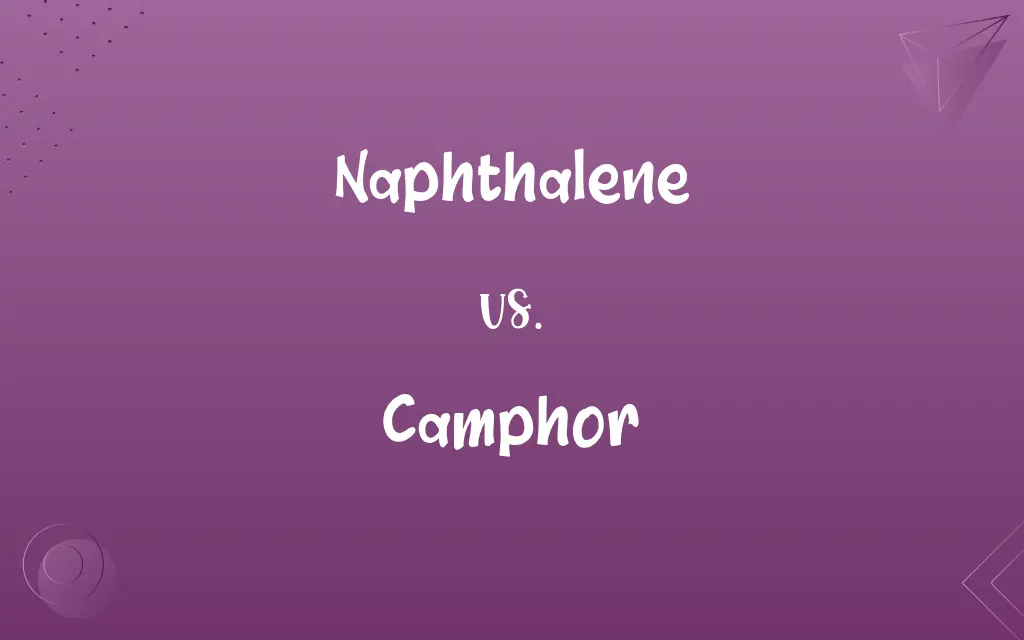Naphthalene vs. Camphor: Know the Difference

By Shumaila Saeed || Updated on December 25, 2023
Naphthalene is an aromatic hydrocarbon used as a moth repellent, while Camphor is a terpenoid with medicinal and aromatic uses.

Key Differences
Naphthalene is a polycyclic aromatic hydrocarbon consisting of two fused benzene rings, making it a simpler molecule. In contrast, Camphor, a terpenoid, has a more complex structure with a bicyclic ring, a ketone group, and an isopropyl group.
Shumaila Saeed
Dec 09, 2023
Naphthalene is widely used as a moth repellent and in the production of other chemicals. Camphor, on the other hand, is known for its medicinal properties, particularly as a topical pain reliever, and is also used in religious ceremonies and as a fragrance.
Shumaila Saeed
Dec 09, 2023
Naphthalene appears as white, volatile crystals with a strong, characteristic odor. Camphor is also crystalline but is distinguished by its strong, aromatic odor and is slightly more volatile.
Shumaila Saeed
Dec 09, 2023
Naphthalene is considered more hazardous, with potential carcinogenic and toxic effects, especially in high concentrations. Camphor is relatively safer but can be toxic if ingested in large quantities.
Shumaila Saeed
Dec 09, 2023
Naphthalene is primarily derived from coal tar or petroleum. Camphor, historically obtained from the camphor laurel tree, is now mostly synthesized from turpentine oil.
Shumaila Saeed
Dec 09, 2023
ADVERTISEMENT
Comparison Chart
Chemical Structure
Two fused benzene rings
Bicyclic terpenoid with ketone and isopropyl groups
Shumaila Saeed
Dec 09, 2023
Primary Use
Moth repellent, chemical production
Medicinal (topical pain reliever), religious, fragrance
Shumaila Saeed
Dec 09, 2023
Physical Appearance
White crystalline substance
White crystalline substance with strong aroma
Shumaila Saeed
Dec 09, 2023
Health and Safety
Potentially carcinogenic and toxic
Toxic in high doses, safer in small quantities
Shumaila Saeed
Dec 09, 2023
Source
Derived from coal tar or petroleum
Historically from camphor laurel, now mostly synthesized from turpentine
Shumaila Saeed
Dec 09, 2023
ADVERTISEMENT
Naphthalene and Camphor Definitions
Naphthalene
A white crystalline substance with a strong odor, used as a moth repellent.
The storage room smelled of naphthalene, keeping the moths away.
Shumaila Saeed
Nov 24, 2023
Camphor
A natural compound found in the wood of the camphor laurel tree.
Traditional medicine often used camphor, sourced from the camphor tree.
Shumaila Saeed
Nov 24, 2023
Naphthalene
An ingredient in various chemical reactions, particularly in organic synthesis.
The laboratory experiment involved the use of naphthalene in a synthesis reaction.
Shumaila Saeed
Nov 24, 2023
Camphor
A substance used in religious ceremonies and as an insect repellent.
The temple air was filled with the scent of burning camphor.
Shumaila Saeed
Nov 24, 2023
Naphthalene
A compound used in the production of dyes, resins, and synthetic fibers.
Naphthalene is essential in creating certain dyes for the textile industry.
Shumaila Saeed
Nov 24, 2023
ADVERTISEMENT
Camphor
A white, crystalline substance with a strong, aromatic odor, used medicinally.
The ointment contained camphor, known for its pain-relieving properties.
Shumaila Saeed
Nov 24, 2023
Naphthalene
A substance considered potentially hazardous and carcinogenic.
Due to its toxic nature, handling naphthalene requires safety precautions.
Shumaila Saeed
Nov 24, 2023
Camphor
A compound that can be toxic if ingested in large amounts.
Although useful, camphor must be used carefully due to its potential toxicity.
Shumaila Saeed
Nov 24, 2023
Naphthalene
A volatile aromatic hydrocarbon derived from coal tar or petroleum.
The industrial plant processed naphthalene as a by-product of coal tar.
Shumaila Saeed
Nov 24, 2023
Camphor
A fragrant white or colorless crystalline ketone, C10H16O, obtained naturally from the wood of the camphor tree or synthesized from pinene and used as an insect repellent, in the manufacture of film, plastics, lacquers, and in medicine chiefly in external preparations to relieve mild pain and itching.
Shumaila Saeed
Oct 19, 2023
Naphthalene
A white crystalline aromatic compound, C10H8, derived from coal tar or petroleum and used in manufacturing dyes, moth repellents, and explosives and as a solvent. Also called tar camphor.
Shumaila Saeed
Oct 19, 2023
Camphor
(organic compound) A white transparent waxy crystalline isoprenoid ketone, 1,7,7-trimethylbicyclo[2.2.1]heptan-2-one, with a strong pungent odour, used in pharmacy.
Shumaila Saeed
Oct 19, 2023
Naphthalene
A white crystalline hydrocarbon manufactured from coal tar; used in mothballs.
Shumaila Saeed
Oct 19, 2023
Camphor
A tough, white, aromatic resin, or gum, obtained from different species of the Laurus family, esp. from Cinnamomum camphara (the Laurus camphora of Linnæus.). Camphor, C10H16O, is volatile and fragrant, and is used in medicine as a diaphoretic, a stimulant, or sedative.
Shumaila Saeed
Oct 19, 2023
Naphthalene
(organic compound) An aromatic bicyclic hydrocarbon, C10H8; an acene containing two fused benzene rings.
Shumaila Saeed
Oct 19, 2023
Camphor
Originally, a gum resembling ordinary camphor, obtained from a tree (Dryobalanops aromatica formerly Dryobalanops camphora) growing in Sumatra and Borneo; now applied to its main constituent, a terpene alcohol obtainable as a white solid C10H18O, called also Borneo camphor, Malay camphor, Malayan camphor, camphor of Borneo, Sumatra camphor, bornyl alcohol, camphol, and borneol. The isomer from Dryobalanops is dextrorotatory; the levoratatory form is obtainable from other species of plants, and the racemic mixture may be obtained by reduction of camphor. It is used in perfumery, and for manufacture of its esters. See Borneol.
Shumaila Saeed
Oct 19, 2023
Naphthalene
A white crystalline aromatic hydrocarbon, C10H8, analogous to benzene, and obtained by the distillation of certain bituminous materials, such as the heavy oil of coal tar. It is the type and basis of a large number of derivatives among organic compounds. Formerly called also naphthaline.
Shumaila Saeed
Oct 19, 2023
Naphthalene
A white crystalline strong-smelling hydrocarbon made from coal tar or petroleum and used in organic synthesis and as a fumigant in mothballs
Shumaila Saeed
Oct 19, 2023
Camphor
A resin obtained from the camphor tree; used in making celluloid and liniment
Shumaila Saeed
Oct 19, 2023
Camphor
A terpenoid with a cooling sensation, used in topical skin applications.
The cooling effect of the camphor was immediate upon applying the cream.
Shumaila Saeed
Nov 24, 2023
Repeatedly Asked Queries
Can naphthalene be naturally sourced?
Naphthalene is typically derived from coal tar or petroleum, not from natural sources.
Shumaila Saeed
Dec 09, 2023
Is naphthalene dangerous?
Naphthalene can be dangerous, especially if inhaled in large quantities, and is considered potentially carcinogenic.
Shumaila Saeed
Dec 09, 2023
Is naphthalene environmentally friendly?
Naphthalene poses environmental concerns due to its toxicity and potential to pollute.
Shumaila Saeed
Dec 09, 2023
Is camphor safe for skin application?
Camphor is generally safe for topical application in small, diluted amounts.
Shumaila Saeed
Dec 09, 2023
What are the physical properties of naphthalene?
Naphthalene appears as white, volatile crystals with a strong, characteristic odor.
Shumaila Saeed
Dec 09, 2023
Is camphor natural or synthetic?
Camphor can be both; it's naturally found in the wood of the camphor laurel tree but is often synthetically produced.
Shumaila Saeed
Dec 09, 2023
Does camphor have a distinct smell?
Yes, camphor is known for its strong, aromatic odor.
Shumaila Saeed
Dec 09, 2023
What is naphthalene commonly used for?
Naphthalene is commonly used as a moth repellent and in chemical manufacturing.
Shumaila Saeed
Dec 09, 2023
Can camphor be ingested?
Camphor should not be ingested as it can be toxic in large quantities.
Shumaila Saeed
Dec 09, 2023
Are there any common products containing naphthalene?
Mothballs and certain insect repellents often contain naphthalene.
Shumaila Saeed
Dec 09, 2023
What are the risks associated with camphor use?
The main risks of camphor use include toxicity if ingested and skin irritation in some individuals.
Shumaila Saeed
Dec 09, 2023
How does naphthalene affect human health?
Naphthalene can affect human health by causing respiratory issues and is potentially carcinogenic.
Shumaila Saeed
Dec 09, 2023
What is camphor used for?
Camphor is used for medicinal purposes, in religious ceremonies, and as a fragrance.
Shumaila Saeed
Dec 09, 2023
How is camphor sourced commercially?
Commercial camphor is mostly synthesized from turpentine oil.
Shumaila Saeed
Dec 09, 2023
Can camphor be used in cooking?
Camphor is not typically used in cooking due to its strong taste and potential toxicity.
Shumaila Saeed
Dec 09, 2023
Is camphor environmentally hazardous?
Camphor is not significantly environmentally hazardous, but its production and disposal should be managed responsibly.
Shumaila Saeed
Dec 09, 2023
What makes naphthalene effective as a moth repellent?
Naphthalene's strong odor and volatile nature make it effective in repelling moths.
Shumaila Saeed
Dec 09, 2023
Can naphthalene be used in households safely?
Naphthalene can be used safely in households if well-ventilated and kept away from children and pets.
Shumaila Saeed
Dec 09, 2023
Can camphor be used in aromatherapy?
Yes, camphor is sometimes used in aromatherapy for its distinct fragrance and perceived therapeutic benefits.
Shumaila Saeed
Dec 09, 2023
Are there alternatives to naphthalene for moth prevention?
Yes, alternatives like cedar wood, lavender, and certain chemical repellents are available.
Shumaila Saeed
Dec 09, 2023
Share this page
Link for your blog / website
HTML
Link to share via messenger
About Author
Written by
Shumaila SaeedShumaila Saeed, an expert content creator with 6 years of experience, specializes in distilling complex topics into easily digestible comparisons, shining a light on the nuances that both inform and educate readers with clarity and accuracy.








































































